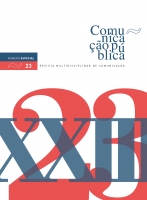Space, photography and ‘factography’ in SPN’s propaganda
DOI:
https://doi.org/10.4000/cp.1877Keywords:
space, photography, propaganda, New State, SPNAbstract
In the early years of the Portuguese’ New State (1933-1974), photography took a decisive role as a vehicle for propaganda. In fact, by adapting international models in vogue and working plastically on the images with the aim of transforming them into ideological messages, a discursive logic was tested and would bear fruit in several publications and exhibitions. However, the boldness of this approach, unprecedented for Portugal until then, soon faded. If in the Portuguese World Exhibition of 1940 not much was left of it, in the post-war period the regime’s propaganda took on another tone in the photographic image - and also in that it adapted, after all, to the spirit of the time.
Downloads
References
Acciaiuoli, M. (1998). Exposições do Estado Novo 1934-1940. Lisboa: Livros Horizonte.
Acciaiuoli, M. (2013). A Vertigem da Palavra. Retórica, Política e Propaganda no Estado Novo. Lisboa: Bizâncio.
Alves, M.B. (2012). O Espaço na Criação Artística do Século XX. Heterogeneidade, Tridimensionalidade, Performatividade. Lisboa: Colibri.
Aslangul, C. (2007). Le Nazisme et les Images. Un Univers Visuel au Service de la Propagande, Avril 2007. [Internet] Disponível em <http://cle.ens-lyon.fr/allemand/le-nazisme-et-les-images-20727.kjsp> [Consult. 9 de Maio de 2017].
Benton, T. (1995). Rome Reclaims its Empire. In: Ades, D., Benton, T., et al (ed.) Art and Power: Europe under the Dictators 1930-1945. London: Thames & Hudson/Hayward Gallery: 120-129.
Bowler, A. (1991). Politics as art: Italian futurism and fascism. Theory and Society, 20 (6) December: 763-794.
Buchloh, B. (1981). Figures of authority, ciphers of regression: notes on the return of representation in European painting. October, 16 Spring: 39-68. DOI : 10.2307/778374 good / bad
Buchloh, B. (2009). De la “Faktura” a la Factografia. In: Ribalta, J. (ed.) Espacios Fotográficos Públicos: Exposiciones de Propaganda de Pressa a The Family of Man, 1928-1955. Barcelona: MACBA: 29-61.
Ferro, A. (2007). Entrevistas a Salazar (pref. F. Rosas). Lisboa: Parceria A.M. Pereira.
Ferro, A. (1921). O elogio do Outono. Ilustração Portuguesa, II Série (817) Outubro, 254.
Ferro, A. (1932a). Falta um realizador. Diário de Notícias. 14/5/1932.
Ferro, A. (1932b). O ditador e a multidão. Diário de Notícias. 31/10/1932.
Folin, A. (1980). Le fascisme ou la socialization du pouvoir comme “Spectacle”. In: Les Realismes 1919-1939. Paris: Centre Georges Pompidou: 366-376.
França, J.A. (1991). A Arte em Portugal no Século XX. Lisboa: Bertrand.
Giardina, A. (2008). O mito fascista da romanidade. Estudos Avançados (ed. Instituto de Estudos Avançados da Universidade de São Paulo), 22 (62): 55-76.
Groys, B. (2008). Educating the Masses: Socialist Realist Art. In: Art and Power. Cambridge, Massachusetts/London: MIT Press: 141-148.
Hintz, B. (1995). “Degenerate” and “Authentic”. Aspects of art and power in the Third Reich. In: Ades, D., Benton, T. et al (ed.) Art and Power: Europe under the Dictators 1930-1945. London: Thames & Hudson/Hayward Gallery, 330-333.
Krauss, R. (2002). Lo Fotográfico - Por una Teoria de los Desplazamientos. Barcelona: Editorial Gustavo Gili, S.A.
Lodder, C. (2014). Revolutionary Photography. In: Abbaspour, M., Daffner, L.N. and Hambourg, M.M., (eds.) Object: Photo. Modern Photographs: The Thomas Walther Collection 1909–1949. An Online Project of The Museum of Modern Art. New York: The Museum of Modern Art. [Internet] Disponível em <http://www.moma.org/interactives/objectphoto/assets/essays/ Lodder.pdf> [Consult. 12 de Novembro 2017]
Lobo, P.R. (2017). O Império de Regresso ao Cais. Imagem e Imaginário Colonial na Arte Portuguesa do Século XX. Tese de Doutoramento em História da Arte, FCSH-Universidade Nova de Lisboa.
Martins, L.P. (2014). Um Império de Papel: Imagens do Colonialismo Português na Imprensa Periódica Ilustrada (1875-1940). Lisboa: Edições 70.
Nisbet, P. (2003). El Lissitzky circa 1935: Two Propaganda Projects reconsidered. In: Perloff, N. and Reed, B., (eds.) Situating El Lissitzky: Vitebsk, Berlin, Moscow. Los Angeles: Getty Research Institute: 211-233.
Pohlmann, U. (2009). Los Diseños de Exposiciones de el Lissitzky. Influencia de su Obra em Alemania, Italia y Estados Unidos, 1923-1943. In: Ribalta, J. (ed.) Espacios Fotográficos Públicos: Exposiciones de Propaganda de Pressa a The Family of Man, 1928-1955. Barcelona: MACBA: 167-191.
Ranta, M. (2010). Narrativity and historicism in national socialist art. Politische Ikonographie. [Internet] Disponível em [Consult. 11 de Maio de 2017].
Revez, N.F.M.P (2012). Os álbuns Portugal 1934 e Portugal 1940 – Dois retratos do país no Estado Novo. Dissertação de Mestrado em História da Arte, FCSH-Universidade Nova de Lisboa.
Salazar, A. O. (1935). Discursos (1928-1934). Coimbra: Coimbra Editora.
Sena, A. (1991). Une Histoire de la Photographie: Portugal 1839 à 1991. Lisboa: Imprensa Nacional Casa da Moeda.
Vargaftig, N. (2014). Para Ver, para Vender: o Papel da Imagem Fotográfica nas Exposições Coloniais Portuguesas (1929-1940). In: Vicente, F. (org.) O Império da Visão. Fotografia no Contexto Colonial Português (1860-1960). Lisboa: Edições 70: 343-352.
Downloads
Published
Issue
Section
License
Copyright (c) 2017 Direitos do Autor (c) 2017

This work is licensed under a Creative Commons Attribution-NonCommercial 4.0 International License.
Os conteúdos da Comunicação Pública estão licenciados com uma licença Creative Commons - Atribuição-NãoComercial 4.0 Internacional.


